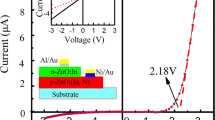Abstract
One of the main obstacles to the technical application of the wide-gap semiconductor ZnO represents the difficulty to achieve reliable p-type doping of ZnO with group V elements (N, P, As, Sb) acting as acceptors located on O lattice sites. The theoretically proposed concepts of cluster-doping or codoping may lead to an enhanced and stable p-type conductivity of ZnO. We report on PAC results obtained by codoping experiments of ZnO by ion implantation using the donor 111In and the group-V acceptor Sb. The formation of In-Sb pairs has been observed. Based on these PAC results, there is no evidence for the formation of In-acceptor complexes involving more than one Sb acceptor. These results has been complemented by photoluminescence measurements.
Similar content being viewed by others
References
Dietl, T., Ohno, H., Matsukura, F., Cibert, J., Ferrand, D.: Zener Model Description of Ferromagnetism in Zinc-Blende Magnetic Semiconductors. Science 287, 1019–1022 (2000)
Morkoç, H., Özgür, Ü.: Zinc Oxide - Fundamentals, Materials and Device Technology. Wiley-VCH, Weinheim (2009)
Look, D.C., B. Claflin, B.: P-type doping and devices based on ZnO. Phys. Stat. Sol. (b) 241, 624–630 (2004)
Avrutin, V., Silversmith, D.J., Morkoç, H.: Doping Asymmetry Problem in ZnO: Current Status and Outlook. Proc. IEEE 98, 1269–1280 (2010)
Zhang, S.B., Wei, S.H., Zunger, A.: Intrinsic n-type versus p-type doping asymmetry and the defect physics of ZnO. Phys. Rev. B 63, 075205 (2001)
Van de Walle, C.G.: Hydrogen as a Cause of Doping in Zinc Oxide. Phys. Rev. Lett. 85, 1012–1015 (2000)
Zeuner, A., Alves, H., Sann, J., Kriegseis, W., Neumann, C., Hofmann, D.M., Meyer, B.K., Hoffmann, A., Haboeck, U., Straßburg, M., Kaschner, A.: Nitrogen doping in bulk and epitaxial ZnO. Phys. Stat. Solidi C 1, 731–734 (2004)
Wang, L.G., Zunger, A.: Cluster-Doping Approach for Wide-Gap Semiconductors: The Case of p-Type ZnO. Phys. Rev. Lett. 90, 256401 (2003)
Yamamoto, T., Katayama-Yoshida, H.: Physics and control of valence states in ZnO by codoping method. Phys. B 302–303, 155–162 (2001)
Yan, Y., Jingbo, L., Su-Huai, W., Al-Jassim, M.M.: Possible Approach to Overcome the Doping Asymmetry in Wideband Gap Semiconductors. Phys. Rev. Lett. 98, 135506 (2007)
Chen, L.L., Lu, J.G., Ye, Z.Z., Lin, Y.M., Zhao, B.H., Ye, Y.M., Li, J.S., Zhu, L.P.: p-type behavior in In–N codoped ZnO thin films. Appl. Phys. Lett. 87, 252106 (2005)
Park, D.-C., Sakaguchi, I., Ohashi, N., Hishita, S., Haneda, H.: SIMS depth profiling of N and In in a ZnO single crystal. Appl. Surf. Sc. 203–204, 359–362 (2003)
Ostheimer, V., Jost, A., Filz, T., Lauer, St., Wolf, H., Wichert, Th.: Atomic Configurations of Group V Acceptors in ZnSe, ZnTe, and CdTe. Appl. Phys. Lett. 69, 2840–2842 (1996)
Park, C.H., Zhang, S.B., Wei, S.-H.: Origin of p-type doping difficulty in ZnO: The impurity perspective. Phys. Rev. B 66, 073202 (2002)
Xiu, F.X., Yang, Z., Mandalapu, L.J., Zhao, D.T., Liu, J.L., Beyermann, W.P.: High-mobility Sb-doped p-type ZnO by molecular-beam epitaxy. Appl. Phys. Lett. 87, 152101 (2005)
Kumar Pandey, S., Kumar Pandey, S., Awasthi, V., Kumar, A., Deshpande, U.P., Gupta, M., Mukherjee, S.: p-type conduction from Sb-doped ZnO thin films grown by dual ion beam sputtering in the absence of oxygen ambient. J. Appl. Phys. 114, 163107 (2013)
Wahl, U., Correia, J.G., Mendonça, T., Decoster, S.: Direct evidence for Sb as a Zn site impurity in ZnO. Appl. Phys. Lett. 94, 261901 (2009)
Limpijumnong, S., Zhang, S.B., Wei, S.-H., Park, C.H.: Doping by Large-Size-Mismatched Impurities: The Microscopic Origin of Arsenic- or Antimony-Doped p-Type Zinc Oxide. Phys. Rev. Lett. 92, 155504 (2004)
Th. Wichert, Th.: Identification of Defects in Semiconductors. Semiconductors and Semimetals, vol. 51B, pp. 297–405 (1999)
Wolf, H., Deubler, S., Forkel, D., Foettinger, H., Iwatschenko-Borho, M., Meyer, F., Renn, M., Witthuhn, W., Helbig, R.: Acceptors and Donors in the Wide-Gap Semiconductors ZnO and SnO2. Materials Science Forum 10–12, 863–867 (1986)
Lany, S., Blaha, P., Hamann, J., Ostheimer, V., Wolf, H., Wichert, Th.: Group V acceptors in CdTe: Ab initio calculation of lattice relaxation and the electric-field gradient. Phys. Rev. B 62, R2259–R2262 (2000)
M. Türker, M., Deicher, M., Wolf, H., Wichert, Th.: The ISOLDE-Collaboration: Donor-acceptor complexes in ZnO. Hyperfine Interact. 197, 173–180 (2010)
Strassburg, M., Rodina, A., Dworzak, M., Haboeck, U., Krestnikov, I.L., Hoffmann, A., Gelhausen, O., Phillips, M.R., Alves, H.R., Zeuner, A., Hofmann, D.M., Meyer, B.K.: Identification of bound exciton complexes in ZnO. Phys. Status Solidi B 241, 607–611 (2004)
Müller, S., Stichtenoth, D., Uhrmacher, M., Hofsäss, H., Ronning, C., Röder, J.: Unambiguous identification of the PL-I 9 line in zinc oxide. Appl. Phys. Lett. 90, 012107 (2007)
Cullen, J., Byrne, D., Johnston, K., McGlynn, E., Henry, M.O.: Chemical identification of luminescence due to Sn and Sb in ZnO. Appl. Phys. Lett. 102, 192110 (2013)
Senthil Kumar, E., Mohammadbeigi, F., Alagha, S., Deng, Z.W., Anderson, I.P., Wintschel, T., Watkins, S.P.: Optical evidence for donor behavior of Sb in ZnO nanowires. Appl. Phys. Lett. 102, 132105 (2013)
Author information
Authors and Affiliations
Corresponding author
Additional information
Proceedings of the 5th Joint International Conference on Hyperfine Interactions and International Symposium on Nuclear Quadrupole Interactions (HFI/NQI 2014) Canberra, Australia, 21–26 September 2014
Rights and permissions
About this article
Cite this article
Türker, M., Deicher, M., Johnston, K. et al. Structural and optical characterization of indium-antimony complexes in ZnO. Hyperfine Interact 230, 65–71 (2015). https://doi.org/10.1007/s10751-014-1075-y
Received:
Accepted:
Published:
Issue Date:
DOI: https://doi.org/10.1007/s10751-014-1075-y




